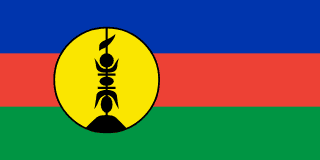New Caledonia - Introduction

Here, let us take a look at some of the important facts about the country New Caledonia. New Caledonia (officially: New Caledonia) is a country in Oceania, precisely in Melanesia, with a population of about 298.1 Thousands inhabitants today (2025-04-03). The capital city of New Caledonia is Nouméa, and the official country TLD code is .nc. New Caledonia has cca2, cca3, cioc, ccn3 codes as NC, NCL, N/A, 540 respectively. Check some other vital information below.
The first humans settled in New Caledonia around 1600 B.C. The Lapita were skilled navigators, and evidence of their pottery around the Pacific has served as a guide for understanding human expansion in the region. Successive waves of migrants from other islands in Melanesia intermarried with the Lapita, giving rise to the Kanak ethnic group considered indigenous to New Caledonia. British explorer James COOK was the first European to visit New Caledonia in 1774, giving it the Latin name for Scotland. Missionaries first landed in New Caledonia in 1840. In 1853, France annexed New Caledonia to preclude any British attempt to claim the island. France declared it a penal colony in 1864 and sent more than 20,000 prisoners to New Caledonia in the ensuing three decades.
Nickel was discovered in 1864, and French prisoners were directed to mine it. France brought in indentured servants and enslaved labor from elsewhere in Southeast Asia to work the mines, blocking Kanaks from accessing the most profitable part of the local economy. In 1878, High Chief ATAI led a rebellion against French rule. The Kanaks were relegated to reservations, leading to periodic smaller uprisings and culminating in a large revolt in 1917 that colonial authorities brutally suppressed. During World War II, New Caledonia became an important base for Allied troops, and the US moved its South Pacific headquarters to the island in 1942. Following the war, France made New Caledonia an overseas territory and granted French citizenship to all inhabitants in 1953, thereby permitting the Kanaks to move off the reservations.
The Kanak nationalist movement began in the 1950s, but most voters chose to remain a territory in an independence referendum in 1958. The European population of New Caledonia boomed in the 1970s with a renewed focus on nickel mining, reigniting Kanak nationalism. Key Kanak leaders were assassinated in the early 1980s, leading to escalating violence and dozens of fatalities. The Matignon Accords of 1988 provided for a 10-year transition period. The Noumea Accord of 1998 transferred increasing governing responsibility from France to New Caledonia over a 20-year period and provided for three independence referenda. In the first held in 2018, voters rejected independence by 57% to 43%; in the second held in 2020, voters rejected independence 53% to 47%. In the third referendum held in 2021, voters rejected independence 96% to 4%; however, a boycott by key Kanak groups spurred challenges about the legitimacy of the vote. Pro-independence parties subsequently won a majority in the New Caledonian Government for the first time. France and New Caledonia officials remain in talks about the status of the territory.
Nickel was discovered in 1864, and French prisoners were directed to mine it. France brought in indentured servants and enslaved labor from elsewhere in Southeast Asia to work the mines, blocking Kanaks from accessing the most profitable part of the local economy. In 1878, High Chief ATAI led a rebellion against French rule. The Kanaks were relegated to reservations, leading to periodic smaller uprisings and culminating in a large revolt in 1917 that colonial authorities brutally suppressed. During World War II, New Caledonia became an important base for Allied troops, and the US moved its South Pacific headquarters to the island in 1942. Following the war, France made New Caledonia an overseas territory and granted French citizenship to all inhabitants in 1953, thereby permitting the Kanaks to move off the reservations.
The Kanak nationalist movement began in the 1950s, but most voters chose to remain a territory in an independence referendum in 1958. The European population of New Caledonia boomed in the 1970s with a renewed focus on nickel mining, reigniting Kanak nationalism. Key Kanak leaders were assassinated in the early 1980s, leading to escalating violence and dozens of fatalities. The Matignon Accords of 1988 provided for a 10-year transition period. The Noumea Accord of 1998 transferred increasing governing responsibility from France to New Caledonia over a 20-year period and provided for three independence referenda. In the first held in 2018, voters rejected independence by 57% to 43%; in the second held in 2020, voters rejected independence 53% to 47%. In the third referendum held in 2021, voters rejected independence 96% to 4%; however, a boycott by key Kanak groups spurred challenges about the legitimacy of the vote. Pro-independence parties subsequently won a majority in the New Caledonian Government for the first time. France and New Caledonia officials remain in talks about the status of the territory.
All Important Facts about New Caledonia
Want to know more about New Caledonia? Check all different factbooks for New Caledonia below.
-
 New Caledonia Factbook
New Caledonia Factbook
-
 The Economy of New Caledonia
The Economy of New Caledonia
-
 Learn about the Government of New Caledonia
Learn about the Government of New Caledonia
-
 Communication in New Caledonia
Communication in New Caledonia
-
 Popular Universities in New Caledonia
Popular Universities in New Caledonia
-
 Enerny in New Caledonia
Enerny in New Caledonia
-
 Transport in New Caledonia
Transport in New Caledonia
-
 The Geography and society of New Caledonia
The Geography and society of New Caledonia
-
 The Environment of New Caledonia
The Environment of New Caledonia
-
 Military and security in New Caledonia
Military and security in New Caledonia